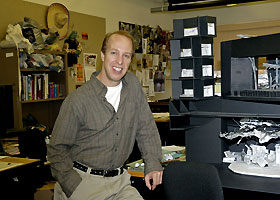For more archives, go to the Advance Archive/Search Page.
Dramatic Arts Professor Sets the Stage
for Scene Design Students
Tim Saternow plucks a tiny replica of a stage set off a crowded shelf in his office. “This is an eighth-inch scale model of the set for The Trojan Women,” says Saternow, an associate professor of dramatic arts and head of scene design. “It’s called a ‘sketch’ model – just pencil on white board – but it’s quite detailed.” Nearby are pieces of a larger model with color and texture.
“We show the models to the director, the shop, and the actors, and use them during the rehearsal process. I love making models,” he says, thumbing through his portfolio. “It’s one of the things that got me hooked on the profession.”
 |
Tim Saternow, an associate professor of dramatic arts who teaches scene design, in the master of fine arts students’ design studio in the Fine Arts Building. |
It’s not surprising that Saternow made scene design his craft of choice. He grew up close to New York City, and always loved going to the theater. He also acted in theater groups in high school, as well as community theater, and enjoyed drawing and painting. “Scene design blended my love of painting and drawing with my love of theater,” he says, “and I decided that’s what I wanted to do.”
He received a master of fine arts degree from the Yale School of Drama in 1987 and came to UConn in 1996.
Saternow has designed for Broadway, Off Broadway, regional theater, film, television, opera, and ballet. He has even designed some restaurants and stores. He received an Emmy nomination for Outstanding Art Direction in 1995 for a special for the Hallmark Hall of Fame production of August Wilson’s The Piano Lesson (CBS).
“I’ve been very lucky,” he says. “As a designer, I’ve been able to do lots of different things. And that’s what I bring to my classes.”
One of the first classes Saternow teaches to freshmen is called Fundamentals of Theatrical Design. “I call it ‘Learning How to See’,” he says. “We begin to look at what’s around us in the everyday world: advertisements, architecture, paintings, and drawings, and we talk about them. We’ll explore whether something is naturalistic, shows distortion, or is abstract.
“We may go from something that is very real, like a photograph of a person, to a distortion like a Picasso. We’ll explore what the artists are trying to do. Is he changing reality or trying to duplicate it? Is he being symbolic and theatrical or leaning toward the naturalistic?” Saternow says. “Ah! Wilderness, performed at UConn several years ago, called for a very realistic space. We duplicated a Victorian house on stage. And for the recent production of Julius Caesar we created an abstraction of a prison, a political prison.”
Saternow says he teaches students the “amazing aspect of collaboration,” which he describes as “one of the strongest and richest parts of being in the theater.
“Scene designers are not in our studios designing in a bubble,” he says. “We’re working with designers for set, light, costume, and sound. We’re working with the play’s director and getting the actors’ input. Even the stage itself will tell us how to approach a design.”
What Saternow likes most about the theater is that “every time I do a new play, I learn something totally different. For Mother Courage, which will open at UConn in February, we’re studying the 30 Years’ War. For A Streetcar named Desire, I learned about New Orleans in the 1940’s. Scenic designers have to be masters at history, painting, architecture, engineering, poetry, and reading. You touch all of it.”
Rows of collages made by students line the wall of a design studio. After reading The New Tenant, an absurdist play by Eugene Ionesco, students were asked to explore their reactions through what Saternow calls “an emotional image collage.” Each of these designers has read the same play, yet they have different reactions to it. Students are also asked to explore the play as a sculpture within a black box. The projects are discussed in class.
“Our students are learning to explore what the visual world means and how we communicate our ideas, purely through visual design,” says Saternow. “Then we’ll move into theater design, where we’re actually on a stage with actors. How do we design something for that? These projects help students think about space in non-traditional ways.”
Saternow says he finds working with students invigorating. “This is new and exciting for them, and that feeds me,” he says.
For all the hard work that goes into designing a show, how does Saternow feel when the stage is dismantled?
“Theater is so weird,” he says. “It’s an art form that lasts for 21/2 hours with an audience in front of it. Otherwise, it doesn’t exist. The magic is when it’s happening. The set as a static art piece isn’t very interesting. What I teach my students is you need that actor, you need that actor’s presence to make it the complete vision.”

